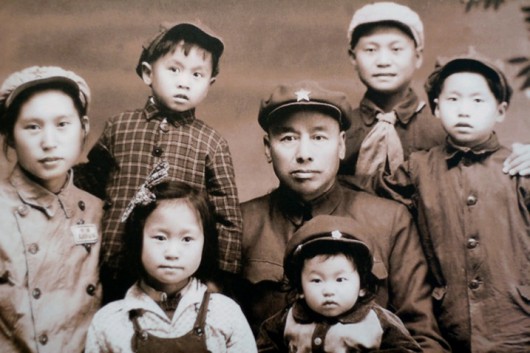
A rifle and sword tied with a red flag over a meter of Gobi sand welcomes visitors to the Xinjiang Production and Construction Corps Museum in the city of Shihezi, 136 kilometers northwest of Ürümchi. This museum, filled with patched and dented artifacts and hundreds of large-scale historical photos, is the premier monument to the Han experience of the recent past in Xinjiang. It shows us the narrative of experience necessary to understand the history of the people who self-identify as “constructors” (jianshezhe) of Xinjiang.
The Bingtuan, as the Corps is referred to by locals, is a state-sponsored farm system spread across the territory of Xinjiang — an area as large as California, Nevada, Utah, Arizona, and New Mexico combined. Hundreds of regiments are still in operation 60 years after their founding. Out of this population of around 3 million military farmers, 90 percent are Han.
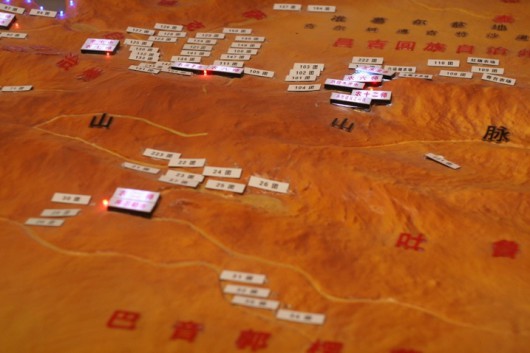
The exhibition begins with giant images of people (at that point, in the early 1950s, mostly men) tilling the soil by yoking themselves together in the place of horses or tractors. The mission of these rehabilitated Guomindang soldiers and reassigned members of the People’s Liberation Army was to claim the soil for agriculture. They dug ditches, carrying away dirt in wheelbarrows; they carried bricks on their backs and “ate bitterness.”
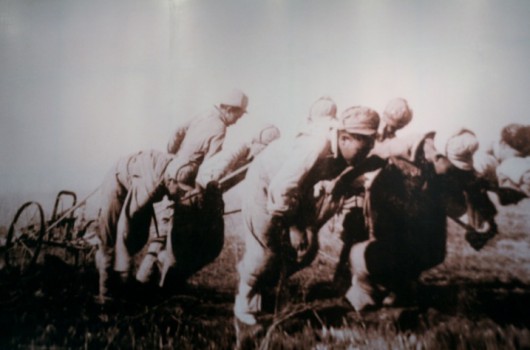
The museum highlights the heroism of these people. In a material illustration of Lei Feng’s sacrificial spirit it shows us the patched coats and socks of these military farmers. Combined with the visceral images of brave suffering in frigid desert winters, these artifacts drive home how extreme the conditions were. We are invited to consider the way water was drunk from dented canteens. Through a wax, wood, and earth diorama we see how the first settlers lived in subterranean rooms dug out of the desert floor.
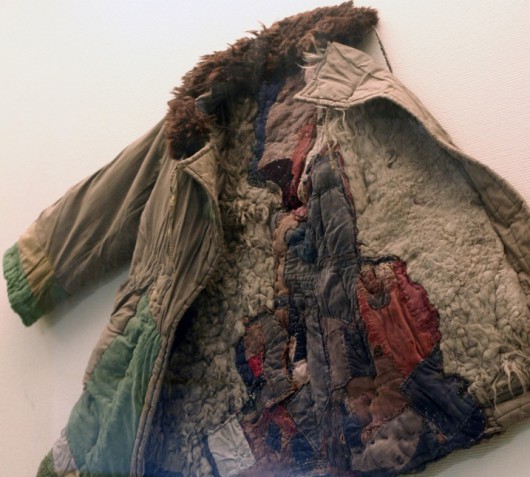
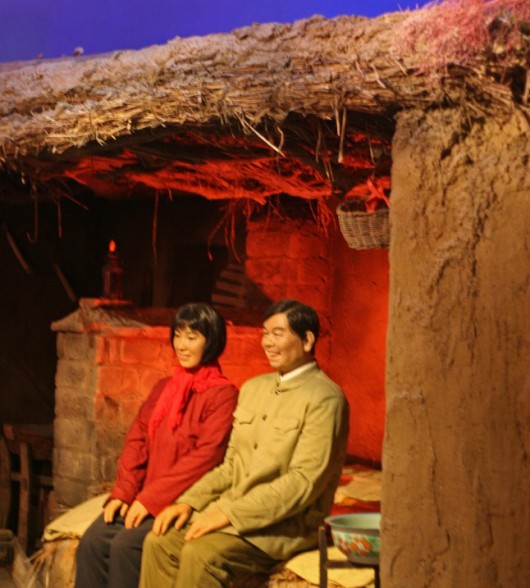
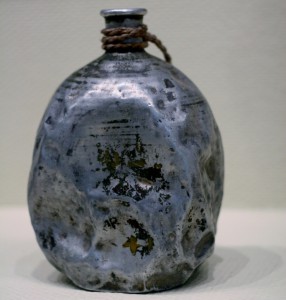
There are images of families, of school children, of choral groups singing Red Songs; there are images of new waterways, of giant vegetables, of new cities. In an elliptical way the exhibit highlights the features that often dominate Western retellings of this history. There is an alcove dedicated to the poet Ai Qing, the famous father of the infamous Ai Weiwei. There are images of Ai with famous intellectuals; a few lines of his verse, but there is little explanation of why he was exiled in the late 1950s to a penal colony within the Bingtuan apparatus.
Even more interesting is a brief retelling of the story of the teenage brides from Shanghai that were rusticated to Xinjiang during the Cultural Revolution. Hundreds of thousands of Shanghaiers were sent to work on Bingtuan farms in the early 1960s. All of these stories of struggle and hardship deserve our attention, but the story of forced marriage of young women to soldier farmers are perhaps the most poignant. Rather than being given military status, these teenagers were relegated to “housewife” status (jiashugong). By not granting them the salary and pension of their male counterparts while at the same time blocking their means of return to their hometowns, this policy forced women toward marriage and thus security. The exhibit invites the viewer to consider this story and highlights the way these women still feel the effects of this reshaping of their lives by showing us images of contemporary reunions of Xinjiang’s Shanghai girls.

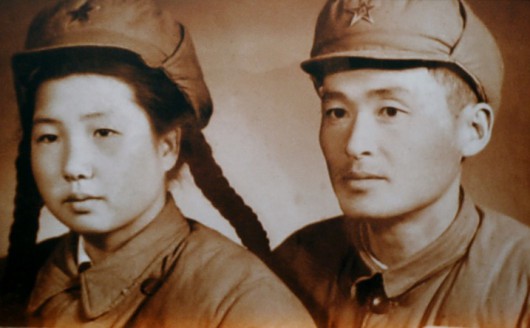
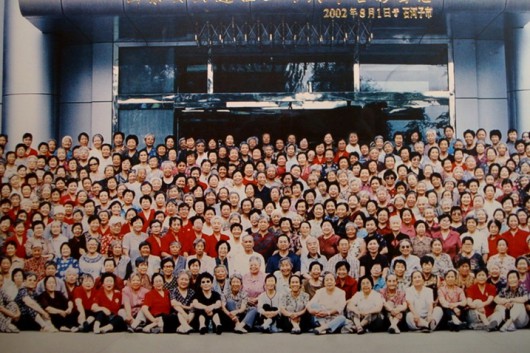
The exhibit ends with an accounting of what has changed in the reform period. All the way through the 1980s Bingtuan farmers were desperately poor. Although they were government employees, the children of Bingtuan farmers often felt they were being born into a life sentence of hard labor. Unlike the flexibility and nominal autonomy of farmers with generic rural household registration or the privilege of those with urban status, those with Bingtuan status often experienced a predetermined life course in which one’s labor was not his or her own. Whole families lived on monthly salaries of 40-50 yuan.
But in the mid-1990s, for-profit oil and gas industries arrived along with new infrastructure and national and transnational markets. Today, the Bingtuan has eight publicly traded subsidiary companies that specialize in information technology, plastics, international trade, alcohol, paper, electricity, and cement, in addition to more traditional products such as cotton, tomatoes, fruit, and sheep. The exhibit highlights how bright the future looks for the children of a secure Xinjiang Bingtuan.


The marginalization of national minorities haunts the narrative of the Bingtuan’s transformation of Xinjiang. Uyghurs appear on the sidelines watching demonstrations of new technologies for turning land into communal farms. They are shown applauding the arrival of great ditches across their land. They sit on the sidelines of Bingtuan heroism.
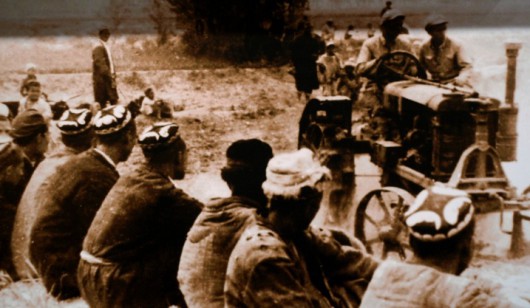
The museum — telling the story of how Xinjiang was made and what it has become — is free and open to the public.
Beige Wind runs the website The Art of Life in Chinese Central Asia, which attempts to recognize and create dialogue around the ways minority people create a durable existence, and, in turn, how these voices from the margins implicate all of us in simultaneously distinctive and connected ways.

















































I’ve come to expect better from this column!
It’s one thing to report on what China puts in a given museum; it’s another to write about it at length without even mentioning how the reality on the ground contradicts the museum’s Han chauvinist and incomplete narrative.
The Bingtuan is nothing less than as a patriotic army of Han settlers holding down the fort in this Turkic-speaking, Muslim-dominated “Wild West,” a virtual state-within-a-state with iron-willed backers in Beijing. The Bingtuan is virtually an occupying force that behaves like a landlord across huge swathes of Xinjiang, which itself covers 1/6 of China’s territory. It has a monopoly on much of Xinjiang’s underground resources and money-making crops like cotton; it employs few non-Han locals, and much of what it takes out of the ground goes elsewhere, with the proceeds going to the central government, not the people of Xinjiang. And it manages much of China’s gulag for political prisoners to boot.
This is well documented in English, and in books like Wang Lixiong’s “My Western Realm, Your Eastern Homeland” (我的西域,你的东土) which is based on his 21st century Xinjiang travels with a Uyghur friend. It is banned in China and available only in Chinese, unfortunately.
A more balanced and more informative view the next time around, please!
Hi Bruce,
Thanks for your thoughtful comments. You’re right to point out that many scholars and journalists have written about the macro-political implications of the settlement project of the Bingtuan. James Millward’s historical overview, David Bachman’s pithy dissection of governance strategies, and Tom Cliff’s analysis of Shihezi as a “neo-oasis” are all well worth reading. Many of the “Xinjiang 13″ (http://bloom.bg/1j13bEg) have also written about it. I allude to some of this by noting that the Bingtuan is 90 percent Han, that it functions as a penal colony for some and that the story told in the museum is the story of the marginalization of the minorities of the region, but perhaps I was depending too much on the reader to pick up on the implications of these indirect references.
My intention was that of drawing attention to the depth of Han perspectives, representations, and experiences in Xinjiang rather than prioritizing the broader implications of the state-generated process of settlement and transformation. If we follow the stories of Han people in the Bingtuan – many of whom identify themselves today as “Lao Xinjiang” – we hear stories of situations over which they had very little control. Extreme poverty, Maoist politics and systematic coercion, all played a role in their inscription into the Bingtuan system. Unlike the profit-seeking migration (XJ is actually the 4th largest receiver of construction workers after Beijing, Shanghai and Guangzhou – see Ren Qiang and Yuan Xin. 2003. “Impacts of Migration to Xinjiang since the 1950s.”) that began in the 1990s this earlier settlement process cannot really be thought of as “voluntary” (the structural violence of China’s hukou system is a major player in this later migration as well).
Although many of the terms of strident macro-politics can be used to describe what is happening in Xinjiang, my feeling is that talking about the lives of everyday people in the categorical terms of absolute critique (chauvinism, racism, colonialism, occupation, terrorism, extremism, separatism etc) does not foster interethnic solidarity and mutual recognition. My goal instead is to describe the micropolitical mechanisms through which people get caught up in structural violence and oppression. Rather than assigning blame I hope to analyze the way contemporary forms of governance result in ethnicity projects, cultural invention, interpersonal agency, transnational linkages and urban development. I start from the premise that “balanced” representation is not really possible and instead attempt to be accurate in my presentation of experience-based evidence of both what has happened and what ought to be. As frustrating as it might be there is a future-oriented politics and an interpersonal ethics of care embedded in the refusal to label phenomena as recognizable things. Given the sensitive nature of the situation I also depend (perhaps too much in this case) on an active and sympathetic readership.
So thanks for reading – I hope my explanation of my intentions gives you a sense of where I am coming from.
CCP Han Chinese “Manifest Destiny”. Big Deal. Next.
And yet, as has been mentioned before in Beige Wind, the local Uyghurs generally see the Han Chinese of the Bingtuan era in a more amicable light compared to the modern economic migrants because they were more inclined to see it as their responsibility to engage with the locals, learn Uyghur and respect local customs and traditions. It is a gross oversimplification to judge the participants of the Bingtuan system as simply a colonizing force of “patriotic Han”, which feels to me like a dismissal of the lived experiences of millions of individuals along ethnic lines and a continuation of the “no Han belongs in Xinjiang” narrative that a lot of Western scholars and Uyghur nationalists clearly espouse.
Interesting comments all! Looks like Beige Wind has some intelligent — and faithful — readers . . .
For those who can read Chinese, here’s a just-published tale of growing up Uyghur in Xinjiang:
我的维吾尔“民族主义”是怎样形成的
http://cn.nytimes.com/china/20140703/cc03mystory/
This is also an example of what is referred to above as “lived experiences,” but not one that will be appearing in a Xinjiang museum (or publication) soon.